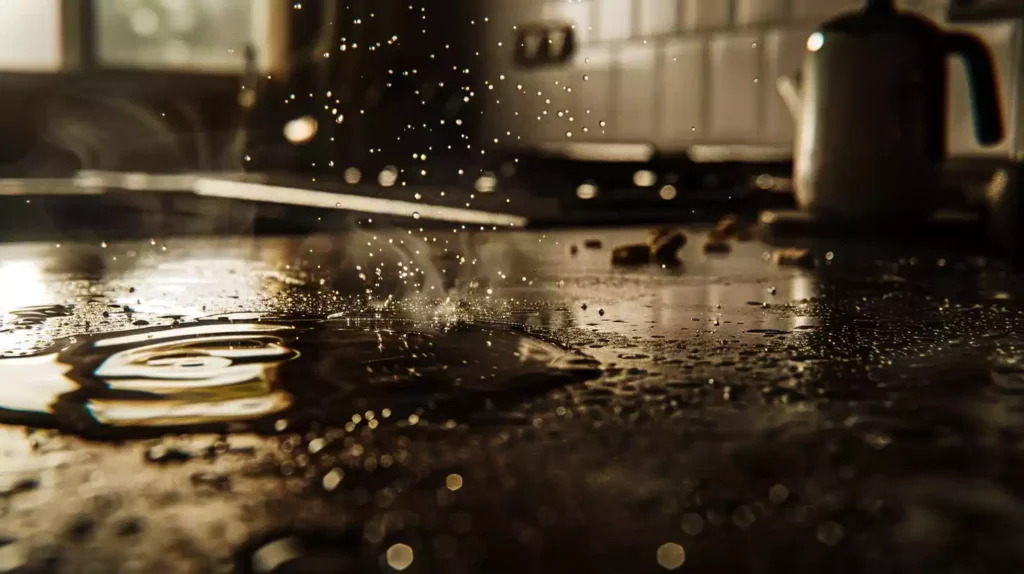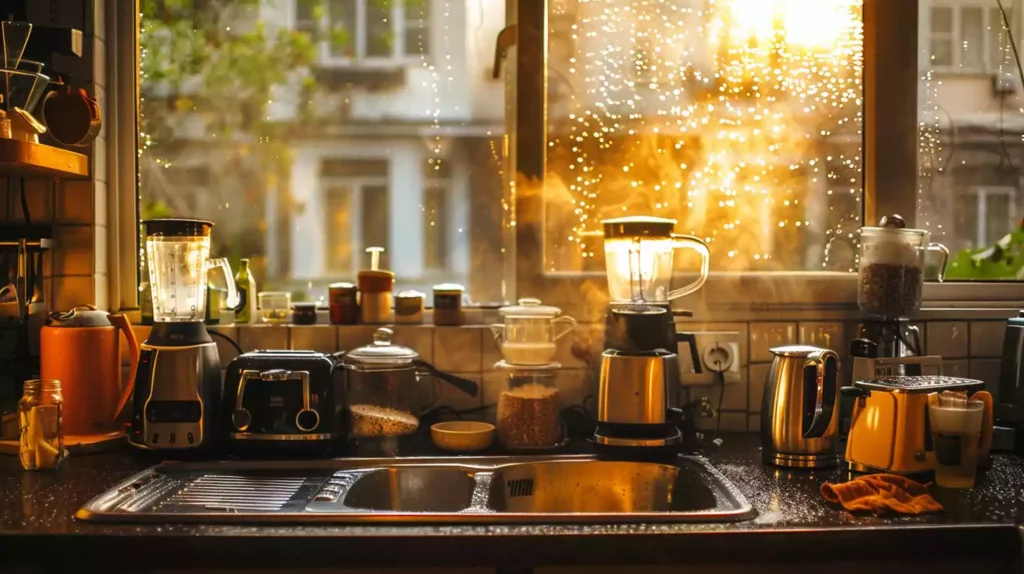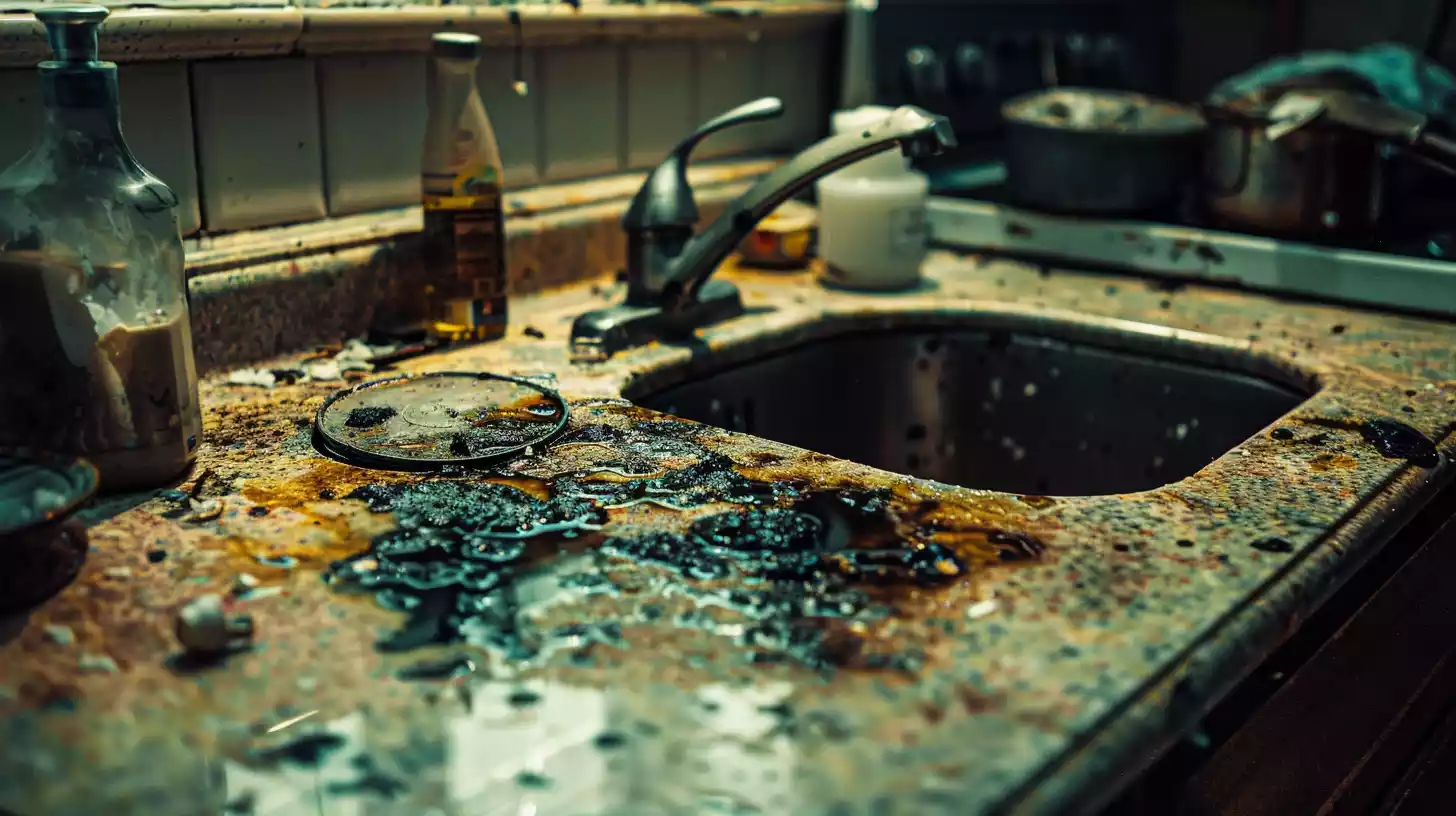I’ve always wondered why my kitchen countertop gets moldy, and it’s not just me – millions of homeowners face this issue every year.
I’ve learned that it’s usually due to excess moisture, poor ventilation, and inadequate cleaning routines.
Cracks and crevices in the countertop provide a breeding ground for mold growth, and spills, leaks, and condensation from cooking can contribute to the problem. Even seemingly harmless habits, like neglecting regular sanitizing or using ineffective cleaning products, can create an ideal environment for mold to thrive.
To really get to the root of the issue, I’ll need to look closer at my kitchen habits and take proactive steps to prevent mold growth.
Quick Summary
- Moisture accumulation from spills, condensation, and poor ventilation creates an ideal environment for mold growth on kitchen countertops.
- Inadequate cleaning routines, including infrequent sanitizing and ineffective cleaning products, allow mold spores to thrive.
- Porous countertop materials like stone, wood, and laminate are more susceptible to mold growth due to their moisture-absorbing nature.
- Trapped moisture from spills, leaks, and humidity can seep into cracks and crevices, providing a breeding ground for mold.
- Failure to maintain and inspect countertop sealants can lead to water intrusion, further contributing to mold growth.
Moisture Accumulation Problems
When I neglect to promptly clean up spills and splatters on my kitchen countertop, I inadvertently create an ideal environment for mold growth, as excess moisture can seep into tiny crevices and cracks, providing a fertile ground for mold to thrive.
This oversight can lead to mold prevention becoming a significant challenge.
To avoid this, I make sure to wipe down my countertops regularly, especially after cooking or cleaning up spills. Moisture control is vital in preventing mold growth, and I achieve this by ensuring that my countertops are dry and clean.
I’ve learned that condensation from running water or steam during cooking can also contribute to mold growth, so I take extra precautions to minimize these effects. By being vigilant about cleaning and drying my countertops, I can prevent mold from taking hold and guarantee a healthy kitchen environment.
Poor Ventilation Consequences
One major contributor to mold growth on my kitchen countertop is poor ventilation, which I’ve learned to address by making sure my kitchen is well-ventilated during and after cooking.
When I don’t provide adequate ventilation, moisture from cooking and other activities lingers, creating an ideal environment for mold to thrive. I’ve realized that frequently leaving kitchen windows closed and not running the exhaust fan while cooking traps moisture in the air, increasing the risk of mold on my countertops.
To combat this, I’ve implemented ventilation solutions such as installing a powerful exhaust fan and opening kitchen windows to let fresh air in. I’ve also developed mold prevention strategies like wiping down countertops immediately after cooking and ensuring good air circulation around my kitchen.
Insufficient Cleaning Routines
I’ve noticed that my kitchen countertop tends to get moldy when I don’t stick to a regular cleaning schedule. If I’m not careful, I might be using the wrong cleaning products or not sanitizing frequently enough, creating an ideal environment for mold to grow.
Infrequent Sanitizing Schedules
In my kitchen, I’ve noticed that neglecting to regularly clean and sanitize countertops can quickly lead to mold growth, as even slight buildup of food residues, spills, and moisture creates an ideal environment for mold to thrive.
This neglect allows mold to spread rapidly, making it essential to prioritize sanitizing schedules to prevent mold proliferation.
Infrequent disinfection of kitchen countertops fails to eliminate mold spores and prevent their subsequent growth, creating a breeding ground for mold. Consistency is key in mold prevention, and a lack of regular sanitizing routines allows organic matter to accumulate, providing a food source for mold.
The importance of sanitizing can’t be overstated, as it’s a vital step in preventing mold growth. By incorporating regular sanitizing into my cleaning routine, I can guarantee a mold-free kitchen.
It’s clear that infrequent sanitizing schedules are a significant contributor to moldy countertops, and making a conscious effort to prioritize sanitizing can make all the difference in maintaining a clean and mold-free kitchen.
Poor Cleaning Products
Since I’ve been relying on ineffective cleaning products, I’ve inadvertently created an environment conducive to mold growth on my kitchen countertops. It’s alarming to think that the very products I trusted to keep my kitchen clean were actually contributing to the problem.
Leaving behind residual moisture: Ineffective cleaning products can leave behind a thin layer of moisture that creates the perfect breeding ground for mold.
Failing to break down organic matter: My cleaning products haven’t been doing their job, leaving behind a buildup of organic matter that mold feeds on.
Not providing preventative measures: Instead of preventing mold growth, my cleaning products have been ineffective in stopping the problem before it starts.
It’s time for me to take action and switch to effective cleaning products that will help prevent mold growth. By doing so, I’ll be taking the first step towards a cleaner, healthier kitchen.
Spills and Leaks Aftermath

After a spill or leak, kitchen countertops can quickly become a breeding ground for mold if the excess moisture isn’t promptly cleaned up and dried. As a homeowner, I’ve learned that it’s vital to act fast when dealing with spills and leaks in the kitchen.
Moisture trapped under or behind the countertop can soak into the surface or underlying materials, providing an ideal environment for mold.
| Common Sources of Moisture | Mold Prevention Strategies |
|---|---|
| Fruit and vegetable spills | Quick cleanup techniques, drying the area thoroughly |
| Leaks from plumbing fixtures | Regularly inspect and maintain plumbing fixtures |
| Dishwasher leaks | Guarantee proper installation and regular maintenance |
| Sink leaks | Fix leaks promptly, dry the area thoroughly |
| Food preparation spills | Clean up spills immediately, dry the area thoroughly |
Humidity Levels in Kitchens
I realize that humidity levels in kitchens play a HUGE role in mold growth.
High humidity sources, such as cooking and washing dishes, create an environment that’s ripe for mold growth, especially when combined with poor ventilation.
High Humidity Sources
I’ve noticed that my kitchen’s humidity levels skyrocket when I’m cooking up a storm, and it’s not just the steam from the stovetop that’s to blame. There are several culprits contributing to the humidity in my kitchen, and I’m willing to bet yours too.
The top humidity offenders in my kitchen are:
- Inadequate ventilation: Not running the kitchen exhaust fan or having poor air circulation creates a humid environment.
- Moisture-rich activities: Cooking, boiling water, and dishwashing all release excess moisture into the air.
- Hot surfaces: Placing hot pots or pans directly on the countertop creates localized areas of high humidity.
To prevent mold growth, it’s essential to practice humidity control and prioritize mold prevention. By being mindful of these humidity sources, I can take steps to reduce the moisture levels in my kitchen and keep my countertops mold-free.
Moisture Traps Formed
In my kitchen, moisture traps are formed when humidity levels surge, creating an ideal environment for mold growth. This usually happens when I’m cooking, boiling water, or washing dishes, releasing excess moisture into the air. Condensation then forms on cool surfaces like my kitchen countertops, providing the perfect breeding ground for mold.
Poor ventilation in my kitchen only worsens the situation, trapping humid air and preventing adequate moisture removal.
Spills and splashes on my countertops can also contribute to the moisture that fuels mold growth. If I don’t clean and dry my kitchen surfaces thoroughly, I’m inviting mold to thrive. Hidden corners and overlooked areas are particularly prone to moisture accumulation, making them hotspots for mold growth.
I need to maintain good kitchen hygiene to prevent these moisture traps from forming. By doing so, I can minimize the risk of mold growth and keep my kitchen countertops clean and safe.
Countertop Material Susceptibility
The material selection process is vital in preventing mold growth. Different countertop materials exhibit varying degrees of susceptibility to mold growth, with some being more prone to water damage and moisture absorption than others.
When it comes to mold growth, not all countertop materials are created equal. The top 3 most susceptible materials are:
- Porous stone: Materials like concrete, wood, and some types of stone are more prone to water damage and moisture absorption, making them a haven for mold growth.
- Laminate and tile: While these materials are moderately resistant to mold growth, the grout and seams can become moldy if not properly sealed and maintained.
- Unsealed solid surfaces: Even nonporous surfaces like solid surfaces, quartz, and stainless steel can develop mold if water damage occurs and isn’t addressed promptly.
To prevent mold growth, it’s essential to choose the appropriate material for your kitchen countertop and implement proper prevention methods, such as regular cleaning and sealing.
By doing so, you can guarantee a mold-free kitchen that’s both functional and beautiful.
Sealant Failure Consequences
Even the most durable surfaces can fall victim to mold growth if their sealants fail. Sealant degradation can lead to mold growth, as it allows moisture to seep in and create an ideal environment for mold formation.
Poorly sealed seams and crevices around the countertop provide entry points for water, making it easier for mold to grow. Exposure to acidic foods and cleaning products can erode the sealant, making the countertop more vulnerable to moisture.
If I fail to clean and maintain my countertop properly, the sealant will deteriorate, creating opportunities for mold to form. Unnoticed spills and leaks can seep under the surface, leading to mold development.
Always address these issues promptly to prevent mold growth. By understanding the consequences of sealant failure, I can take proactive steps to protect my countertop and prevent mold growth.
Common Kitchen Sources of Moisture

Moisture is the main culprit behind the mold issue on your kitchen countertop. Moisture can easily accumulate in the kitchen, creating the perfect breeding ground for mold.
Common kitchen sources of moisture that are likely contributing to the problem include:
- Humid kitchen environment
- Leaky faucets
- Leaky drains
Addressing these moisture sources will be crucial in resolving the mold issue on your kitchen countertop.
Humid Kitchen Environment
Improve ventilation: Open windows, use exhaust fans or install a dehumidifier to reduce moisture in the air.
Dry surfaces: Wipe down countertops and appliances regularly to prevent water spots and condensation.
Clean up spills: Promptly clean and dry any spills or messes to prevent moisture from accumulating.
Leaky Faucets and Drains
Leaky faucets and drains in my kitchen have become a constant battle, slowly dripping water onto the countertops and creating a perfect storm for mold growth. A single dripping faucet or clogged drain can release water onto the countertop surface, providing the perfect breeding ground for mold.
Improperly sealed or cracked caulking around sinks can also allow water to seep underneath the countertop, further exacerbating the problem. It’s imperative to address these issues promptly to avoid costly repairs and health hazards.
I’ve learned that even the smallest of leaks can cause significant water damage over time. Failure to do so can lead to significant water damage and create an ideal environment for mold to thrive.
I highly recommend to prioritize plumbing maintenance to prevent these issues. By staying on top of plumbing maintenance and addressing leaks promptly, I can reduce the risk of mold growth and keep my kitchen countertops safe and healthy.
Ignoring Initial Mold Growth
When I dismiss those initial signs of mold on my kitchen countertops, I inadvertently create an environment that allows the mold to spread and thrive. By ignoring the early warning signs, I’m giving mold the green light to take over my kitchen. It’s easy to overlook a small patch of mold, but neglecting it can have serious consequences.
Mold spreads like wildfire. When I ignore mold, it can quickly spread to other areas of my kitchen, including walls, cabinets, and appliances.
Health risks escalate. Mold exposure can trigger allergic reactions, respiratory issues, and even neurological problems. The longer I wait, the higher the risk to my health and my family’s well-being.
Kitchen damage intensifies. Unchecked mold growth can lead to costly repairs, replacements, and even structural damage to my kitchen.
Early detection and mold prevention are pivotal to avoiding these devastating consequences. By staying vigilant and addressing mold issues promptly, I can safeguard my kitchen and my health.
Neglecting Regular Maintenance
As I fail to prioritize regular maintenance, my kitchen countertops become a breeding ground for mold growth, allowing it to flourish unnoticed. Neglecting regular cleaning and drying of my countertops creates an ideal environment for mold to thrive.
Spills and splashes that aren’t promptly wiped up, combined with insufficient ventilation and high humidity levels in my kitchen, contribute to the perfect storm for mold growth. Failing to seal or reseal my countertop material makes it more vulnerable to moisture absorption, further exacerbating the issue.
Poor cutting board hygiene, with trapped food particles and moisture, can facilitate mold spreading to the surrounding countertop. By neglecting regular maintenance, I’m effectively inviting mold to take over my kitchen.
To prevent this, I need to prioritize mold prevention through regular cleaning and drying of my countertops. By staying on top of maintenance, I can prevent mold growth and keep my kitchen countertops safe and healthy.

